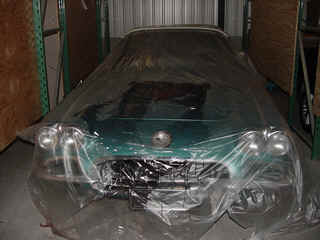
Transport and Frame Number
I can assure you, nothing is so exciting as your first meeting with your first Corvette, especially if you bought it at the other side of the earth and you had to wait for it to arrive for more than a month (well, maybe the birth of you first child, but I would know because I haven't been there yet). But the 23rd of September 2003 it finally was going to happen...
Love at first sight, Frame Number
It's a pity you are not allowed to drive a just imported car on the Dutch roads. Therefore we found the firm Roks from Hoogeveen willing to help us shipping the car from Rotterdam to our village Limmen (app. a 50 mile drive) using their car ambulance (is this a American expression ?). Because on 1959 cars the VIN number is stamped on the small plate which itself not properly fixated on the bodywork (only held in its place by the two philips head screws) we had to drive our new car via the RDW in Amsterdam to get the VIN number of the car stamped in the car frame.

I was so excited the night before we were going to get our car that I was hardly sleeping that night and at 6 am I was already awake to start this exciting day! That morning we took our regular car (Alfa Romeo 156) and drove swiftly to Rotterdam. There we met DaniŽlle Roks and her mother who were going to help us picking up and transporting the car that day. The custom paperwork was quickly filled in and the 6% Dutch sales tax paid in cash together with the transport and insurance cost and then... ...into the warehouse to finally meet our new car!
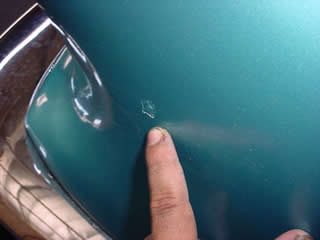
There he was, in a dark corner of the warehouse it was standing, waiting for its new owner. Slowing I approached the car, I could hardly believe the moment finally arrived to meet our new addition of our little family. I could hardly believe my eyes. The car looked smashing, even better than I expected it to be. The chippings and other imperfections on the body work were minor, the plating was almost perfect, and flaws were hardly noticeable. Half in the dark I stepped into the car and inspected the dashboard, switches and levers.
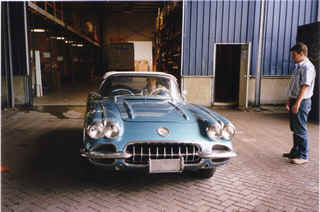
I turned the ignition key and... nothing happened. The car didn't make a sound, not even a little cough. Not surprisingly because the shipper already mentioned the battery should be disconnected during the transport so quickly we attached the battery cable and gave it a second try. Again the car didn't show any signs of life, apparently the battery was empty. Luckily DaniŽlle brought a starter kit which we could attach to the battery to try for a third attempt. Again, with sweety hands I try to start the car; this time I was more lucky, the starter engine did its job and after a few attempts the engine took over. Slowly I drove forward and tried the reverse, all seemed to work fine!
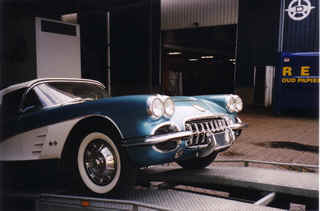
Then I had to drive our priceless new car on the trailer. I can assure you, this is one of these things which turn your hair grey in seconds! Imagine, you have never drove your new classic car and you have to get it, via two small, not visible (because hidden by the enormous nose of the car) strips onto the trailer without knowing how to handle the hand brake yet (I hadn't figure out the working of this device at that time). Half way the engine stopped and because the battery was flat I could restart the car again. I finally managed to get the car on the hand brake and by pushing (with the help of 3 other persons) we got the car on the trailer. I can assure you, I was so relived we succeeded to get the car on it safely.
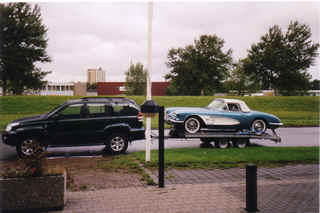
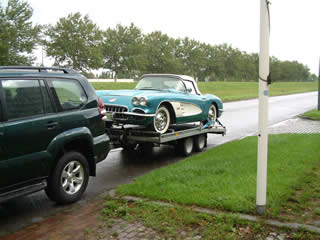
So, on our way for the second step of the final phase of the shipping process: we went to the RDW to get the VIN number stamped in the frame of our car. Without this number engraved in the cars skeleton we were not allowed to get it technically approved, to get our Dutch license number for the car. We had to follow our new Corvette, using the Alfa for the next hour to get, on time, in Amsterdam...
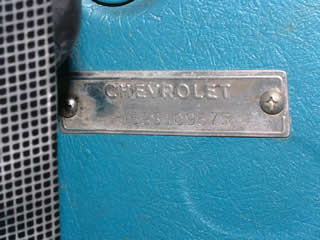
Doing the needed paperwork at the RDW was done in a few minutes (which is not bad at all for a Dutch government organization). Because we arrived an hour early we were actually 50 minutes ahead on schedule but this wasn't a problem they could help us right away to get the VIN number engraved. Luckily we didn't have to get the car of the trailer because surely I would survived a second attempt getting it back on it again. The technical engineer took his flashlight and started searching for the VIN number. Directly I pointed out the aluminum plate near the left door to him but he ensured me there should be a number already stamped in the body work by the Corvette factory. I assured him this was not the case because in 1959 this wasn't done as a factory procedure but he didn't care less. After a 45 minute search conducted by him and four of his colleagues he concluded one of the found numbers on the engine itself (probably a casting number) would do as well. I ensured them the VIN number was the nubmer they should use to identify the car instead and since it was running late and, at home, the wife with the hot meatballs were waiting they agreed to use this number to be the one to use to engrave the car.
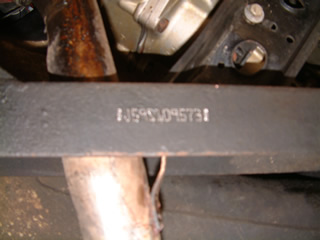
Recently it came to my ears that the frame number should already be available on the existing Corvette frame. If you open the drain plug near the right seat you should be able to read the frame number. The photo below shows the drain plug but the plug is also mentioned in Noland's Restoration Guide on page 209. I haven't checked this because I have to tear my carpet to confirm this.
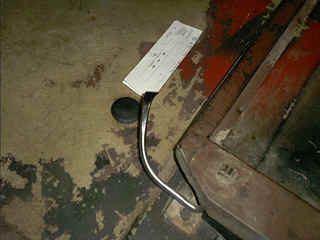
(photo Jim Vance)
After this last hurdle we had to drive another 15 miles to get to Limmen. Carefully we unloaded the car and drove it into our garage...